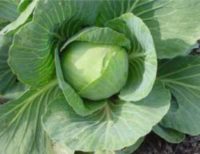Cabbage
 Cabbage comes in many sizes, shapes and colors - Cannon , Dutch, Jersey Wakefield pointed and red, Ruby Ball and Savoy cabbage with its blue-green to light green crinkled leaves and creamy center. There is Chinese Cabbage that we will talk about later.
Cabbage comes in many sizes, shapes and colors - Cannon , Dutch, Jersey Wakefield pointed and red, Ruby Ball and Savoy cabbage with its blue-green to light green crinkled leaves and creamy center. There is Chinese Cabbage that we will talk about later.
The Japanese have developed several hybrids in the past few years that resist splitting in warm weather (late spring here) and early varieties that would be good for spring planting here.
Cabbage is easy to grow in all areas if planted to mature in cool weather. Seeds germinate quickly at 70 degrees and a few days later at 59 degrees. Because the plant needs cool temperature to mature, it is best to start your own transplants with the variety of seed you want to grow. Nursery grown transplants are not usually named hybrids. Early varieties, inland, (in San Diego County) do not grow well as an early fall crop due to the still warm soil and daytime temperatures during late Sept. to the first part of November. It is better to use the early varieties, 60 -65 days for early spring planting and use the mid and late maturing varieties for fall transplants.
Start seed about 5 weeks before setting out transplants. Cabbage does well with decreasing day length, however, fall plantings grow more slowly than early spring plantings. A variety that has a 70 day maturity date might take 30 days longer depending on our winter temperatures.
Cabbage grows well in soil high in organic matter and composted manure. Or use compost for soil amending and 16 - 20 - 0 as a pre- plant fertilizer, lightly applied. Space plants 12-30 inches apart. New gardeners are surprised at the size of a mature cabbage. Some of the large Savoy cabbages will take the width of a 4 foot bed. General spacing is 12 to 18 inches for small varieties and 2 to 30 inches for large varieties with 2 to 3 feet between rows. On raised beds, space plants 12 - 18 inches apart on a staggered pattern. Set transplants a little deeper in the ground, but don't bury bottom leaves. Avoid compressing the soil around the root ball as it retards root growth. Do not buy nursery transplants if they are root bound and stalks are kinked. Cabbage does very well under rows covered with cloth like Reemay and with drip irrigation.
Also check out ...
http://vric.ucdavis.edu/veg_info_crop/cabbage.htm
http://www.ipm.ucdavis.edu/PMG/selectnewpest.cole-crops.html
Planting Dates
Coastal:
Plants can be set out from September to February. Seeds can be planted from August to December.
Inland:
Plants can be set out from September to February. Seeds can be planted from August to October.
Varieties
- Savoy Ace (85 days) large plant
- Savoy King (90 days) large plant
- Spivoy Hybrid (50 days) is a small 15 - 18 inch diameter Savoy type for the garden
- Treta (55 days) is a conical headed cabbage
- Stonehead (70 days) is one of the Japanese hybrids and an All American winner.
- Emerald Cross Hybrid (63 days) is a Chinese Cabbage firm, round, red head.

